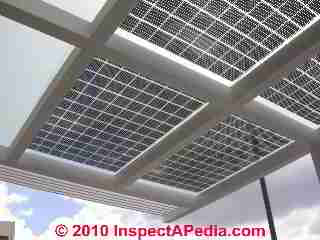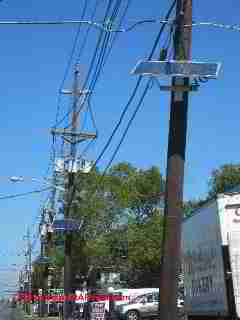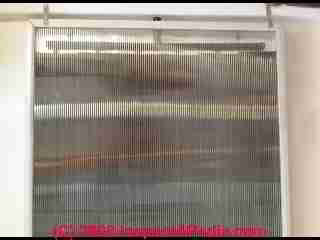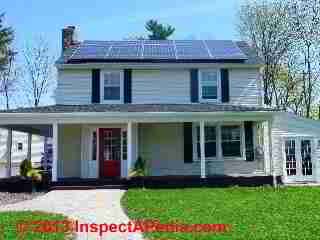 Solar & Renewable Energy
Solar & Renewable Energy
Home page & Article Index
- POST a QUESTION or COMMENT about solar design and solar energy systems for homes
This page provides an index to key articles about solar energy design & products. We include descriptions of solar energy system types, uses, and best practices for solar energy system installation.
These solar energy articles discuss in deteail how to choose, install, diagnose, & repair renewable energy systems for buildings including active and passive solar heating & solar hot water heating systems, solar powered electrical systems (photovoltaics), along with building insulation & ventilation design & retrofit tips to save energy where solar or other alternative energy systems are in use or planned.
InspectAPedia tolerates no conflicts of interest. We have no relationship with advertisers, products, or services discussed at this website.
Solar Energy Designs & Retrofit Improvements in Buildings
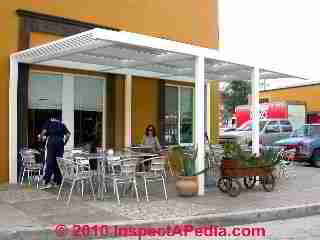
The green power solar electrical panel array shown above is distributed by Desmex Solar and is installed in San Miguel de Allende, Mexico.
The solar energy system shown here and just below provides all of the electrical energy required by a small restaurant, including powering lighting and nine refrigerators and coolers in the building.
To find what you need quickly, if you don't want to scroll through this index you are welcome to use the page top or bottom SEARCH BOX to search InspectApedia for specific articles and information.
Article Contents
- Definition of PASSIVE SOLAR Systems
- Definition of SOLAR-THERMAL Systems
- Definition of PHOTOVOLTAIC CELL Solar Systems
- Solar GRID-TIED vs DISTRIBUTED Solar Systems
- SOLAR WATER HEATERS
- SOLAR DESIGN BOOKS, GUIDES
- SOLAR HEATED SWIMING POOL
- WHERE TO BUY solar energy systems: supplier list
- ALTERNATIVE ENERGY , Green Energy, Energy-Savings Topics & Articles Supporting Solar Energy Systems & Designs
Our page top photo illustrates an extensive photovoltaic solar panel system installed on a building providing commercial rental space in New Paltz, N.Y. The property owners expect a rapid payback on the system cost thanks in part to government incentive program assistance.
Satisfied with the performance of the solar panels in reducing building electrical costs the owners intend to install a similar system on residential apartment space in New Paltz as well.
Solar Energy Articles, Information, Products, Sources
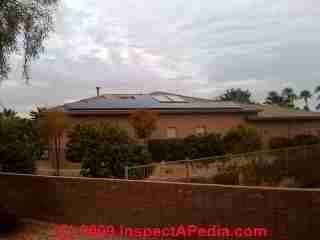 Our articles listed below provide detail about solar energy sources, installation, maintenance, inspection, diagnosis, and repair.
Our articles listed below provide detail about solar energy sources, installation, maintenance, inspection, diagnosis, and repair.
Articles in this series include solar energy, solar heating, solar hot water, and related building energy efficiency improvement articles including material reprinted/adapted/excerpted with permission from Solar Age Magazine - editor Steven Bliss.
We include links to solar design guides and other authoritative sources.
Our photograph (left) shows solar panels, both photovoltaic and domestic hot water heating systems, on a rooftop in Surprise, Arizona.
According to the Pennsylvania DEP who provide a nice introduction to solar power, solar energy systems are divided into three major categories: passive solar systems, solar-thermal systems, and photovoltaic solar systems.
The text below is adapted and expanded upon from that source:
Definition of Passive Solar Systems: Using Building Design Features to Take Advantage of & Control Solar Heat Gain
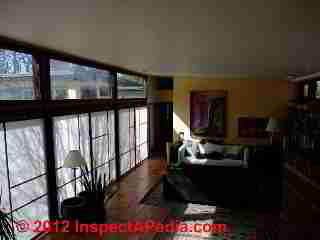
Passive solar designtakes advantage of a building's structure to capture the sun's heat, either storing or distributing it, reducing the need for conventional heating, cooling and/or lighting.
Examples of passive solar design include large, south-facing windows, dark colored tile floors , stone fireplaces, brick interior walls, "sunspaces" (or greenhouses) and super-insulation.
Passive solar buildings are often equipped with features, such as overhangs and ventilation systems, which keep them cool in the summer months and warm in the winter months.
Passive solar buildings may also make use of special window glazing to control un-wanted heat loss in cold weather and un-wanted gain in hot weather.
See details about each of the solar topics just mentioned above at our page bottom RECOMMENDED ARTICLES
Our passive solar gain photo (above left) is from the author's New York home.
The effectiveness of passive solar heating is discussed
at PASSIVE SOLAR HEAT PERFORMANCE.
See PASSIVE SOLAR HOME, LOW COST for an example of a low-budget passive solar design.
Definition of Solar-Thermal Systems: Using Solar Energy to Heat Water to Operate Electricity-Generating Turbines
Power plants often use fossil fuels as a heat source to boil water. The steam from the boiling water then rotates a large turbine, activating a generator that produces electricity. Solar-thermal concentrating systems use sunlight as the heat source, eliminating the need for fossil fuels.
There are three types of solar-thermal concentrating systems & parabolic troughs, parabolic dishes and central receivers. Parabolic troughs, primarily used for industrial purposes, are curved reflectors that focus sunlight into a line receiver in which fluid is heated.
Parabolic dishes, also used in industrial applications, are bowl-shaped reflectors that focus sunlight into a small receiver through which passes a heat-transfer fluid. Central receivers, which have traditionally dominated the U.S. Department of Energy's solar thermal program, are sun-tracking mirrors that focus sunlight onto a large receiver.
Residential heating of water using solar systems is not in turn for the generation of electrical power as the PA DEP outlined above, but rather to produce domestic hot water or in some cases, heat storage or to heat swimming pools.
Details are
at SWIMMING POOL SOLAR HEAT, INDOOR.
Special applications of solar heating or boiling of water of interest to smaller-scale users includes SOLAR WATER DISINFECTION such as might be used at a remote cabin or in areas where potable water is not available.
Definition of Photovoltaic Cell Solar Systems: Using Solar Energy to Create Electricity in Arrays of Devices that Change Sunlight into Electrical Energy
Photovoltaic (PV) cells, or solar cells, convert sunlight directly into electricity. [A photovoltaic cell is an electrical device made of layers of semiconductor materials that are excited by sunlight and give off electrical energy.]
As the sun strikes a PV cell the semi-conducting materials within the cell absorb the sunlight, producing electricity. Solar cells are often used as simple systems that power small calculators and wristwatches. More complicated systems provide electricity for pumping water, powering communications equipment, lighting homes, and running appliances.
Details are at PHOTOVOLTAIC POWER SYSTEMS
In residential applications, photovoltaics are also popular for remote cabins where conventional electrical power is not available.
REMOTE ELECTRIC POWER, PHOTOVOLTAIC
A series of solar cells form a PV array or "solar panel." Between 10 and 50 solar panels are needed to power an average household. PV panels are installed on buildings in places of maximum sun and minimal shade in order to take full advantage of the sun's power. There is very little maintenance required to sustain solar equipment.
So long as panels are kept clean, they can last approximately 20 to 30 years. Also
see SOLAR COLLECTOR EFFICIENCY COMPARISONS.
Our photovoltaic solar panel photo (above left) shows the use of passive solar energy to power street lighting in Haddonfield, New Jersey.
Solar Grid-Tied vs Distributed Solar Systems
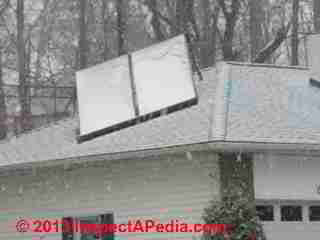
Our photo illustrates snow-coated solar hot water heating system panels on a Poughkeepsie NY rooftop during snowy winter weather.
A solar grid-tied system links a series of solar panels through a power inverter to the utility's electric grid. The solar panels generate a direct current (DC) by drawing on energy from the sun.
The inverter then converts that direct current to an alternating current (AC), which electronic devices and appliances can use. Batteries are not necessary to supplement the system and any excess electricity generated by the solar panels is redirected by the inverter back into the grid where it can be used on other premises.
Distributed solar systems work independently from a utility's electric grid, using batteries to store the power.
Similar to a grid-tied system, distributed solar panels typically use a power inverter to convert the direct current from the sun into an alternating current, to be used on location. However, some systems function without an inverter and run only DC appliances.
Solar Energy Information at InspectApedia
- SOLAR ENERGY SYSTEMS - Information Articles
- BLOCKBED RADIANT FLOORS - SOLAR DESIGN - how we design a concrete block floor for thermal mass &radiant heat distribution, flow rates, air movement, block sizes, etc.
- PASSIVE SOLAR DESIGN HANDBOOK - 3 volumes of detailed solar design specs from the USAF (PDF files)
- PASSIVE SOLAR DESIGN KEY ELEMENTS - what are the key elements in passive solar design? - US DOE (supplemented with additional photos, commentary, text)
- PASSIVE SOLAR DESIGN METHOD - combination solar systems involving water well, direct gain, and Trombe wall in one building
- PASSIVE SOLAR ENERGY MONITORING - how to monitor or evaluate the performance of a passive solar home
- PASSIVE SOLAR FLOOR TILES, PHASE CHANGE -
- PASSIVE SOLAR HEAT PERFORMANCE - how to more accurately calculate the passive solar contribution to energy savings
- PASSIVE SOLAR HOME, LOW COST - case study describes a low-budget but highly effective passive solar home
- PASSIVE SOLAR PERFORMANCE PROBE
- PHOTOVOLTAIC POWER SYSTEMS - electrical power generation systems using solar energy
- REMOTE ELECTRIC POWER, PHOTOVOLTAIC - off the grid power supply for remote buildings, cabins, camps
- SLAB INSULATION, RADIANT / PASSIVE SOLAR - what insulation thickness is needed under a passive-solar heated slab floor?
- SOLAR COLLECTOR AIR or GAS COLLECTION - does air collecting in solar panels mean corrosion? how to purge solar collector air.
- SOLAR COLLECTOR FILMS - do light-transmitting, heat reflecting films offer efficiency gains for solar collectors?
- SOLAR HEATING SYSTEMS - see Passive Solar articles above
- SOLAR HOT WATER HEATERS - how to obtain domestic hot water using solar energy
- SOLAR HOUSE EVALUATION - how "solar" is your house - measures of percent solar
- SOLAR SHADE OVERHANGS, ROOF & WINDOW
- SOLAR WATER DISINFECTION
- SOLAR WELL PUMPS - sun / solar power operated pumps
- Solar Swimming Pool Heating
- SWIMMING POOL SOLAR HEAT, OUTDOOR DIAGNOSIS - diagnosing a solar pool heater that was not warming the swimming pool
- SOLAR COLLECTOR AIR or GAS COLLECTION - meaning of air or gas bubbles in a swimming pool solar panel
- SWIMMING POOL SOLAR HEAT, INDOOR - swimming pool heating, moisture control, insulation placement
- "Conserving Energy and Heating Your Swimming Pool With Solar Energy", U.S. Department of Energy
- "SWIMMING POOL HEATING" cost savings suggestions from the U.S. DOE includes suggestions
- on using a high efficiency (GAS-FIRED SWIMMING POOL HEATERr
- or heat pump swimming pool heater)
- or HEAT PUMP SWIMMING POOL HEATER
- using SWIMMING POOL COVERS
- managing SWIMMING POOL WATER TEMPERATURES
- and installing a more ENERGY EFFICIENT SWIMMING POOL PUMP, or using it less.
- SOLAR WATER HEATERS - sources & types of solar hot water heating systems
- SUNGAIN, FILMS, LOW-E GLASS - review of window and glazing glass coating, number of layers of glazing, low-e, energy efficiency
Solar Water Heating Systems
Solar water heaters use renewable energy - sunlight - collected in outdoor rooftop or ground-mounted solar collectors to heat water which is circulated by a pump between a hot water storage tank and the panels.
The upper end of a simple solar water heater collector is shown in our photo at left. Look closely and behind the corrugated plastic surface, at the top you can see the horizontal black tubing that moves water through the top end of this collector.
Solar water heaters have been in use for decades, with popular use at remote cottages or off-the-grid buildings and are likely to see increasing use in much of the world as energy costs continue to climb.
- SOLAR WATER HEATERS discusses the basic types of solar hot water heating systems and provides links to in-depth information from a variety of expert sources
List of Solar Heating Systems, Panels, Controls, Components, Packaged Systems
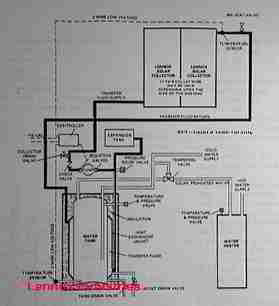 Sketch courtesy of Lennox Industries.
Sketch courtesy of Lennox Industries.
- Access Water Energy, PO Box 2061, Moorabbin, VIC 3189, Australia, Tel: 1300 797 758, email: sales@accesswater.com.au Moorabbin Office: Kingston Trade Centre, 100 Cochranes Rd, Moorabbin, VIC 3189 Australia, Web: .accesswater.com.au
Australian supplier of: Greywater systems, Solar power to grid packages, Edwards solar systems, Vulcan compact solar systems, water & solar system pumps & controls, and a wide rage of above ground & under ground water storage tanks: concrete, steel, plastic, modular, and bladder storage tanks. - American Solar Energy Society, 2525 Arapahoe Ave, Ste E4-253 Boulder, Colorado 80302 Email: info@ases.orgWeb: https://ases.org/ Tel: (303) 443-3130 (MWF 10-Noon)
- 2 Watt Monocrystalline Solar Cells, Hughes Solar Energy
Superior Class A Monocrystalline Solar Cells. These cells have no facial marring and a uniform deep blue phosphorous layer. These cells are used to create high-quality, DIY solar panels and can be assembled in series to make solar modules that exceed production quality, while saving hundreds of dollars off retail.
There are now a lot of online sellers selling Evergreen,Motech and German castoff cells that do not rate as the advertised wattage or are thin line errs.We have never done this and never will.
We do not prey upon the lack of knowledge of new,inexperienced buyers and want solar accepted and used as widely as possible.Its is not only good for business but the future of solar energy! This sale is for 36 solar cells. - Sunforce 22010 12-Watt Folding Solar Panel, Sunforce
- Sunforce 37015 60-Watt Solar Panel - Crystalline, Sunforce,
The Sunforce 37015 60 Watt Crystalline Solar Panel is designed for RVs, homes, boats, back-up and remote power use, 12-volt battery charging, and solar power stations. Built with high efficiency crystalline cells, this weatherproof panel is easy to install and comes equipped with wiring, brackets and screws.
And for more power, you can easily connect multiple panels. This panel has a maximum output of 60 watts and 4 amps. - Sunforce 7 Amp Charge Controller
The Sunforce 60012 7 Amp Charge Controller prevents overcharging of 12-volt batteries. It is intended for use with 12-volt solar panels, and can handle up to 7 amps of array current and up to 100 watts of solar power.
The controller is easy to use with a charging light that indicates that your battery is charging, and a green light that indicates a fully charged battery. The 60012 measures 4 x 1 x 2.5 inches (WxHxD) and weighs one pound. - Sunforce 50044 60-Watt Solar Charging Kit
The Sunforce 50044 60 Watt Solar Charging Kit gives you another reason to love the sun -- it'll help keep your batteries charged. This kit is excellent for cabins, remote power, back-up power, and 12-volt battery charging.
The kit includes a PVC mounting frame, 7 Amp charge controller, 200-watt inverter, and wiring/connection cables. And with the built-in blocking diode technology, this charger kit is designed to protect against battery discharge at night.
You can also use this kit to maintain the charge on any 12-volt battery for clean, silent operation of various electronics, such as deer feeders and landscaping pumps. The 50044 features a built-in ultra-bright blue LED charging indicator, and is a great choice for automobiles, recreational vehicles (RV), tractors, all terrain vehicles (ATV), boats, electric fences, telemetry and more, and it is even effective on cloudy days.
This battery charger kit is made of durable ABS plastic and amorphous solar cells and has a maximum temperature range of -40 to 176-degrees Fahrenheit. - Cobra CPI 1575 1500 Watt 12 Volt DC to 120 Volt AC Power Inverter, 1500 Watts Continuous Power, 3000 Watts Peak Power, Three grounded AC receptacles and 5-Volt USB output - [Quoting]
This inverter provides household power on the go. It converts battery power to 120 V AC household power, allowing you to power up office equipment and household appliances from your vehicle. This unit is ideal for such appliances as microwave ovens (1000 watts or less), coffee makers, laptops, TVs, video game consoles, CD and DVD players, cell phone chargers, and more. - Cobra CPI-A4000BC AC Power Inverter AWG Cables
Solar Heating Design, Installation, Repair Books, Solar Pumps, Manuals
- Solar Design Books and Guides
- PASSIVE SOLAR DESIGN KEY ELEMENTS - what are the key elements in passive solar design? - US DOE (supplemented with additional photos, commentary, text) - Online text
- PASSIVE SOLAR DESIGN HANDBOOK VOLUME I [PDF], [PDF] the Passive Solar Handbook Introduction to Passive Solar Concepts, in a version used by the U.S. Air force - online version available at this link and from the USAF also at wbdg.org/ccb/AF/AFH/pshbk_v1.pdf
- PASSIVE SOLAR DESIGN HANDBOOK VOLUME II [PDF], [PDF] the Passive Solar Handbook Comprehensive Planning Guide, in a version used by the U.S. Air force - online version available at this link and from the USAF also at wbdg.org/ccb/AF/AFH/pshbk_v2.pdf [This is a large PDF file that can take a while to load]
- PASSIVE SOLAR HANDBOOK VOLUME III [PDF], [PDF] the Passive Solar Handbook Programming Guide, in a version used by the U.S. Air force - online version available at this link and from the USAF also at wbdg.org/ccb/AF/AFH/pshbk_v3.pdf
- The Passive Solar Design and Construction Handbook, Steven Winter Associates (Author), Michael J. Crosbie (Editor), Wiley & Sons, ISBN 978-047118382 or 0471183083 is available at Amazon.com and via the The Passive Solar Design and Construction Handbook, Steven Winter Associates (Author), Michael J. Crosbie (Editor), Wiley & Sons, ISBN 978-047118382 or 0471183083
- "PASSIVE SOLAR HOME DESIGN [PDF] ", [PDF] U.S. Department of Energy, describes using a home's windows, walls, and floors to collect and store solar energy for winter heating and also rejecting solar heat in warm weather
- SOLCOST USERS GUIDE [PDF] (1980) Solar Energy Design Program for Non-Thermal Specialists, Ver. 3.0. Martin Marietta Data Systems, Denver Division, Denver Colorado
Excerpt: This Users Guide documets the data inputs for the SOLCOST Solar Energy Design Program. SOLCOST is intend~d for use by architects, contractors, engineers, and other members of HVAC industry responsible for making decisions on economically justifiable investments in solar energy heating and cooling systems.
The input data requirements have been simplified so non-thermal specialists can easily use the program to generate an estimate of thermal performance and the resulting payback or rate of return from a proposal solar project. SOLCOST was developed by Martin Marietta for DOE's Division of Solar Energy, Research and Development Branch and updated by the Solar Environmental Engineering Company. - The Homeowner's Guide to Renewable Energy: Achieving Energy Independence through Solar, Wind, Biomass and Hydropower (Mother Earth News Wiser Living), Dan Chiras, ISBN13: 9780865715363
The coming energy crisis caused by a peak in global oil and natural gas production will profoundly affect the lives of all North Americans. As the price of these vital fuels rises, homeowners will scramble to cut their fuel bills. Two options for meeting the upcoming challenge are dramatic improvements in home energy efficiency and efforts to tap into clean, affordable, renewable energy resources to heat and cool homes, to provide hot water and electricity, and even to cook.
These measures can result in huge savings and a level of energy independence.
The Homeowner’s Guide to Renewable Energy tells you how. It starts by outlining the likely impacts of fossil fuel shortages and some basic facts about energy. It then discusses energy conservation to slash energy bills and prepare for renewable energy options.
Focusing carefully on specific strategies needed to replace specific fuels, the book then examines each practical energy option available to homeowners:
• Solar hot water, cooking, and water purification
• Space heat: passive and active solar retrofits
• Wood heat
• Passive cooling
• Solar electricity
• Wind-generated electricity
• Electricity from microhydropower sources
• Emerging technologies—hydrogen, fuel cells, methane digesters, and biodiesel
The Homeowner’s Guide to Renewable Energy gives readers sufficient knowledge to hire and communicate effectively with contractors and, for those wanting do installations themselves, it recommends more detailed manuals. With a complete resource listing, this well-illustrated and accessible guide is a perfect companion for illuminating the coming dark age. - The Renewable Energy Handbook, Revised Edition: The Updated Comprehensive Guide to Renewable Energy and Independent Living, William H. Kemp,
This revised edition of The Renewable Energy Handbook focuses on the unique requirements of off-grid living as well as using "green" energy for homeowners who remain connected to the electrical utility. The book contains chapters on:
* Energy efficiency and economics
* Home heating and cooling and domestic water heating
* Photovoltaic, wind, and micro-hydro energy generation
* Battery selection and inverters
* Backup power, wireless communications, etc.
It includes comprehensive specifications for many of the products available in the market today. Whether you are just curious or an industry expert, this handbook will show you how to stretch your energy dollars (doing much more with less) while powering your home with renewable energy.
And, unlike fossil fuels or nuclear energy, renewable energy frees you from worry about dumping today's pollution on tomorrow's children. Since its release in 2003, The Renewable Energy Handbook has been a top-selling technology book and is recognized as the best in its field.
This edition has been fully revised for 2010 and beyond. It has been increased in size to an easy-to-read 8 x 10 inch format, and it is augmented with hundreds of illustrations, line drawings, photographs, and appendices. - Solar Engineering of Thermal Processes, John A. Duffie, William A. Beckman, Wiley; 3rd Ed (August 25, 2006), ISBN-10: 0471698679, ISBN-13: 978-0471698678
The updated, cornerstone engineering resource of solar energy theory and applications. Solar technologies already provide energy for heat, light, hot water, electricity, and cooling for homes, businesses, and industry.
Because solar energy only accounts for one-tenth of a percent of primary energy demand, relatively small increases in market penetration can lead to very rapid growth rates in the industry? which is exactly what has been projected for coming years as the world moves away from carbon-based energy production.
Solar Engineering of Thermal Processes, Third Edition provides the latest thinking and practices for engineering solar technologies and using them in various markets. - Solar Power Your Home For Dummies, Rik DeGunther, ISBN13: 9780470596784, [Quoting]
Want to take advantage of solar power in your home? Whether you’re looking to save on your energy costs by adding a few solar components or you want to build a solar-powered house from the ground up, Solar Power For Dummies, 2nd Edition takes the mystery out of this energy source and shows you how to put it to work for you!
This new edition gives you hands-on tips and techniques for making your home more energy-efficient though solar power—and helping the planet at the same time. Plus, you’ll get all the latest information on changes to federal, state, and local regulations, laws, and tax incentives that seek to make solar-power adoption more feasible. - Solar Electricity Handbook: 2010 Edition, A Simple Practical Guide to Solar Energy - Designing and Installing Photovoltaic Solar Electric Systems, Michael Boxwell
The Solar Electricity Handbook is a practical and straightforward guide to using electric solar panels.
Assuming no previous knowledge of solar panels, the book explains how solar panels work, how they can be used and explains the steps you need to take to successfully design and install a solar electric system from scratch using photovoltaic solar panels.
Accompanying this book is a solar resource website containing lots of useful information, lists of suppliers and on-line solar energy calculators that will simplify the cost analysis and design processes. - Solar System Pumps, IO Manuals, Sources: pumps for use with solar systems
Smart Water Shop (Australia), SOLAR PUMP KIT USER’S MANUAL SolarFree 1600C Supreme [PDF], Smart Water, 13/899 Wellington Road, Rowville, 3178 Victoria Australia, Tel: 03 9808 4067 Service email: service@smartwatercorp.com.au retrieved 2018/05/20, original source: https://smartwatershop.com.au/media/2094/1432789561.SolarFree1600Cusermanual.pdf
SMPT SOLAR PUMP CONTROLLER USER MANUAL [PDF] Sunman-Energy, (Hong Kong) (2016), Tel: 400 969 2800, Website: www.sunman-energy.com retrieved 2018/05/20, original source: http://www.sunman-energy.com/Upload/File_xw47c9fetxrw.pdf Offices world wide. Oceania, Level 9, 153 Walker St., North Sydney NSW 2060 Australia, Email: sales@sunman-energy.com Tel: +86-400-969-2800
SunRotor, SUNROTOR® SOLAR PUMP INSTALLATION AND RESOURCE MANUAL [PDF] Solar Power & Pump Co., Tel: 866-246-7652, Website: www.sunrotorcom, - retrieved 2018/05/20, original source: https://www.sunrotor.com/sites/default/files/pdfs/Installation_Guide.pdf
- Solar Powered Water Pumps & Fountain Pumps|
See our web page:
SOLAR WELL PUMPS - sun / solar power operated pumps for wells, pools, and for solar systems themselves
Aquapro DC SOLAR PANEL SUBMERSIBLE PUMP KIT [PDF], Aquatec Equipment Co., Website: Aquatecequipment.com retrieved 2018/05/20, original source: https://system.na2.netsuite.com/core/media/media.nl ?id=89096&c=4144647&h =d030ee074bfea5996ec8&_xt=.pdf
Morales, Teresa D., John Busch, DESIGN OF SMALL PHOTOVOLTAIC (PV) SOLAR-POWERED WATER PUMP SYSTEMS [PDF] (2012) (Watt Estimator for Solar Powered Pump System Spreadsheet), Technical Note 29 (Portland, OR as revised for New Mexico) USDA, NRCS, New Mexico, retrieved 2022/05/30 original source: https://efotg.sc.egov.usda.gov/references/public/NM/eng4a2-Design_Of_Small_Photovoltaic(Pv)Solar-Powered_Water_Pump_Systems.pdf
NASS, SOLAR POWERED DEEP WELL PUMP IO MANUAL [PDF] North American Solar Solutions, Pump Division, Website: http://www.solardcpumps.com/ (no mailing address) retrieved 2018/05/20, original source: http://www.solardcpumps.com/PDF/DeepWellPumps/2017_V2_Nass_Deep_well_pump_10-12-14_Rev_A.pdf
Sunnydaze Decor Solar Pump for operating a fountain, pool, pond using solar panel power USERS MANUAL [PDF] retrieved 2018/05/20, original source: https://www.serenityhealth.com/content/Instructions/F981 Solar rock%20fountain - Instruction.pdf
Sunpumps, SOLAR PUMP IO MANUAL for SOLAR ELECTRIC PUMPS [PDF] SCS 1, 1 1/2 & 2 HP series solar electric pumps, Sunpumps 325 East Main Street Safford, AZ 85546 USA Tel # (928) 348-9652
Ylaya, Vrian Jay V., and Ruel T. Buba. PERFORMANCE ANALYSIS OF SOLAR POWERED WATER WELL PUMP [PDF]” International Research Journal of Advanced Engineering and Science, Volume 7, Issue 2, pp. 85-89, 2022.
Abstract
The Philippines is abundant in water. In remote areas, sources of water are from wells. The collection of water needs effort and is laborious. Mechanical pumps are available to collect water from the well automatically, but this is impossible in remote areas deprived of electricity.
This research addresses the later issue: water pumps are powered with solar. The performance of the solar-powered water well pump is analyzed from their series and parallel connections based on the provided flow rate—data analysis using a two-tailed ttest implemented in Python.
The Ho is that there is no significant difference in the flow rate of series and parallel connections of the solar-powered water well pump. The p-value solve is 1.346, which rejects the null hypothesis. Thus, there is a significant difference in the performance of series and parallel connections of the solar-powered water well pump.
Efficiently, a parallel connection performed well in implementing a solar-powered water well pump.
- Solar Power (Energy for Today), Tea Benduhn,
[Review quote]
Packaged in a small, square format, this title presents a surprising amount of information about solar power in brief sentences that are calibrated to newly confident readers’ abilities. The short chapters start with essential definitions of terms such as solar system before moving into topics such as renewable energy and greenhouse gases.
The selection of well-chosen color photos, which are crisply reproduced on each page, is particularly strong in final chapters about solar technology, and the close-up images of a solar-powered car and tent will attract young browsers. Readers will likely need help with advanced concepts, for example, global warming, which is illustrated with a helpful diagram, but the language is direct, clear, and enlightening. A short glossary, resource list, and index close this strong title in the Energy for Today series.
This will partner well with Helen Orme’s Energy for the Future, also reviewed in this issue, in elementary units on the environment. Grades 2-4. --Gillian Engberg - Solar Power Your Home For Dummies, Rik DeGunther
Want to take advantage of solar power in your home? Whether you’re looking to save on your energy costs by adding a few solar components or you want to build a solar-powered house from the ground up, Solar Power For Dummies takes the mystery out of this energy source and shows you how to put it to work for you!
This friendly, hands-on guide is packed with tips for making your home more energy-efficient though solar power—and helping the planet at the same time. You’ll see how to survey your home to determine your current household energy efficiency and use, and evaluate where solar power would best benefit you.
You’ll also calculate what the return on your investment will be before you make any decisions. Once you’ve decided on a project, you’ll see whether it’s best to hire a contractor or do it yourself. We leave no stone unturned - Solar Revolution: The Economic Transformation of the Global Energy Industry, Travis Bradford,ISBN13: 9780262524940
In Solar Revolution, fund manager and former corporate buyout specialist Travis Bradford argues—on the basis of standard business and economic forecasting models—that over the next two decades solar energy will increasingly become the best and cheapest choice for most electricity and energy applications. Solar Revolution outlines the path by which the transition to solar technology and sustainable energy practices will occur.
Developments in the photovoltaic (PV) industry over the last ten years have made direct electricity generation from PV cells a cost-effective and feasible energy solution, despite the common view that PV technology appeals only to a premium niche market. Bradford shows that PV electricity today has become the choice of hundreds of thousands of mainstream homeowners and businesses in many markets worldwide, including Japan, Germany, and the American Southwest.
Solar energy will eventually be the cheapest source of energy in nearly all markets and locations because PV can bypass the aging and fragile electricity grid and deliver its power directly to the end user, fundamentally changing the underlying economics of energy. As the scale of PV production increases and costs continue to decline at historic rates, demand for PV electricity will outpace supply of systems for years to come.
Ultimately, the shift from fossil fuels to solar energy will take place not because solar energy is better for the environment or energy security, or because of future government subsidies or as yet undeveloped technology. The solar revolution is already occurring through decisions made by self-interested energy users.
The shift to solar energy is inevitable and will be as transformative as the last century's revolutions in information and communication technologies. - Solar Water Heating: A Comprehensive Guide to Solar Water and Space Heating Systems, (Mother Earth News Wiser Living Series), Bob Ramlow, Benjamin Nusz, ISBN13: 9780865715615
Heating water with the sun is almost as old as humankind itself, and it is done all over the world. Yet there are strangely few resources on the topic in North America.
Solar Water Heating fills this gap. It reviews the history of solar water and space heating systems from prehistory to the present, then presents the basics of solar water heating, including an introduction to modern solar energy systems, energy conservation and energy economics. Drawing on the author’s experience as an installer of these systems, the book goes on to cover:
* Types of solar collectors, solar water and space heating systems and solar pool heating systems, including their advantages and disadvantages
* System components, their installation, operation, and maintenance
* System sizing and siting *
Choosing the appropriate system.
Since people often get turned off by the up-front cost, the book focuses especially on the financial aspects of solar water or space heating systems, clearly showing that such systems can save significant costs in the long run. Well-illustrated, the book is designed for a wide readership from the curious to the student or professional. - Solar Cooking: web search 07/20/2010, original source:
http://cfpub.epa.gov/ncer_abstracts/index.cfm/fuseaction/display.abstractDetail/abstract/8820
User-friendly Solar Ovens for Outdoor and Indoor Use,
Investigators: Li, Peiwen, Institution: University of Arizona, EPA Project Officer: Nolt-Helms, Cynthia, Project Period: August 15, 2008 through August 14, 2009,
Objective: The goal of this project is to develop safer and user-friendly solar ovens for indoor and outdoor cooking. Use sunlight for cooking has long been envisioned as an energy saving and clean technology that can greatly benefit people.
Currently, solar ovens and solar cooking devices mostly use parabolic dish or trough reflectors to concentrate sunlight. It is often unsafe or unpleasant for people to access a cooker which stands at a focus point in front of a reflector.
They can easily expose themselves to the concentrated sunlight accidentally. Blockage of sunlight by people moving around the concentrator is also disadvantageous for the receiver to get the maximum amount of sunlight. Therefore making a solar cooking device to be highly safe and user-friendly, and even capable of indoor use is the objective of this research.
Approach: Instead of reflective solar concentrators, large Fresnel lenses are to be used to concentrate solar light. Fresnel lenses manufactured using the state-of-the-art technology and material are thin, light weight, and cost effective.
For outdoor cooking, the focused sunlight is casted on a heat dissipation metal block, which receives and conducts solar heat to a hot surface. The concentrated sunlight is effectively protected from exposure to people who operate and cook. Optical fiber cable is to be developed to transfer the concentrated sunlight into a house and provides heat to indoor cooking device. Strong sunlight will be well harnessed in such a process, and safety is assured.
A capstone senior design team by six students from mechanical engineering and optical engineering will be formed to carry out the research, design, and prototype fabrication in the Department of Aerospace and Mechanical Engineering at the University of Arizona.
Expected Results: Prototype solar ovens will be built, which includes an effective solar tracking control system, a Fresnel lens and optical system, and a metal block serving for heat conduction and hot surface. The power level of the solar oven for outdoor cooking or barbeque is projected to be around 1000 W.
For indoor solar oven, the power level largely depends on the effective solar light transferring technique to be developed in the project. The targeted power level is around 500W.
Supplemental Keywords: Solar energy, User-friendly solar oven, Sustainable development, Clean technology, Innovative technology, Heat transfer, Thermal protection, Optical system, Multi-Disciplinary, - USDA, RENEWABLE ENERGY SOLAR ENERGY PRIMER, USDA, NRCS, - retrieved 2022/05/30, original source: https://www.nrcs.usda.gov/Internet/FSE_DOCUMENTS/nrcs144p2_066677.pdf Power point presentation
Alternative Energy, Green Energy, Energy-Savings Topics & Articles Supporting Solar Energy Systems & Designs
See the INDEX to RELATED ARTICLES given below
...
Continue reading at PASSIVE SOLAR DESIGN METHOD or select a topic from the closely-related articles below, or see the complete ARTICLE INDEX.
Or see these
Recommended Articles
Suggested citation for this web page
SOLAR ENERGY SYSTEMS at InspectApedia.com - online encyclopedia of building & environmental inspection, testing, diagnosis, repair, & problem prevention advice.
Or see this
INDEX to RELATED ARTICLES: ARTICLE INDEX to SOLAR ENERGY
Or use the SEARCH BOX found below to Ask a Question or Search InspectApedia
Ask a Question or Search InspectApedia
Try the search box just below, or if you prefer, post a question or comment in the Comments box below and we will respond promptly.
Search the InspectApedia website
Note: appearance of your Comment below may be delayed: if your comment contains an image, photograph, web link, or text that looks to the software as if it might be a web link, your posting will appear after it has been approved by a moderator. Apologies for the delay.
Only one image can be added per comment but you can post as many comments, and therefore images, as you like.
You will not receive a notification when a response to your question has been posted.
Please bookmark this page to make it easy for you to check back for our response.
Our Comment Box is provided by Countable Web Productions countable.ca
Citations & References
In addition to any citations in the article above, a full list is available on request.
- [1] "Energy Savers: Whole-House Supply Ventilation Systems [copy on file as /interiors/Energy_Savers_Whole-House_Supply_Vent.pdf ] - ", U.S. Department of Energy energysavers.gov/your_home/insulation_airsealing/index.cfm/mytopic=11880?print
- "Energy Savers: Whole-House Exhaust Ventilation Systems [copy on file as /interiors/Energy_Savers_Whole-House_Exhaust.pdf ] - ", U.S. Department of Energy energysavers.gov/your_home/insulation_airsealing/index.cfm/mytopic=11870
- "Energy Savers: Ventilation [copy on file as /interiors/Energy_Savers_Ventilation.pdf ] - ", U.S. Department of Energy
- "Energy Savers: Natural Ventilation [copy on file as /interiors/Energy_Savers_Natural_Ventilation.pdf ] - ", U.S. Department of Energy
- "Energy Savers: Energy Recovery Ventilation Systems [copy on file as /interiors/Energy_Savers_Energy_Recovery_Venting.pdf ] - ", U.S. Department of Energy energysavers.gov/your_home/insulation_airsealing/index.cfm/mytopic=11900
- "Energy Savers: Detecting Air Leaks [copy on file as /interiors/Energy_Savers_Detect_Air_Leaks.pdf ] - ", U.S. Department of Energy
- "Energy Savers: Air Sealing [copy on file as /interiors/Energy_Savers_Air_Sealing_1.pdf ] - ", U.S. Department of Energy
- Solar Age Magazine was the official publication of the American Solar Energy Society. The contemporary solar energy magazine associated with the Society is Solar Today. "Established in 1954, the nonprofit American Solar Energy Society (ASES) is the nation's leading association of solar professionals & advocates. Our mission is to inspire an era of energy innovation and speed the transition to a sustainable energy economy. We advance education, research and policy. Leading for more than 50 years. ASES leads national efforts to increase the use of solar energy, energy efficiency and other sustainable technologies in the U.S. We publish the award-winning SOLAR TODAY magazine, organize and present the ASES National Solar Conference and lead the ASES National Solar Tour – the largest grassroots solar event in the world."
- Steve Bliss's Building Advisor at buildingadvisor.com helps homeowners & contractors plan & complete successful building & remodeling projects: buying land, site work, building design, cost estimating, materials & components, & project management through complete construction. Email: info@buildingadvisor.com
Steven Bliss served as editorial director and co-publisher of The Journal of Light Construction for 16 years and previously as building technology editor for Progressive Builder and Solar Age magazines. He worked in the building trades as a carpenter and design/build contractor for more than ten years and holds a masters degree from the Harvard Graduate School of Education. Excerpts from his recent book, Best Practices Guide to Residential Construction, Wiley (November 18, 2005) ISBN-10: 0471648361, ISBN-13: 978-0471648369, appear throughout this website, with permission and courtesy of Wiley & Sons. Best Practices Guide is available from the publisher, J. Wiley & Sons, and also at Amazon.com - Mark Cramer Inspection Services Mark Cramer, Tampa Florida, Mr. Cramer is a past president of ASHI, the American Society of Home Inspectors and is a Florida home inspector and home inspection educator. Mr. Cramer serves on the ASHI Home Inspection Standards. Contact Mark Cramer at: 727-595-4211 mark@BestTampaInspector.com
- John Cranor [Website: /www.house-whisperer.com ] is an ASHI member and a home inspector (The House Whisperer) is located in Glen Allen, VA 23060. He is also a contributor to InspectApedia.com in several technical areas such as plumbing and appliances (dryer vents). Contact Mr. Cranor at 804-873-8534 or by Email: johncranor@verizon.net
- "Conserving Energy and Heating Your Swimming Pool With Solar Energy", U.S. Department of Energy
- Desmex Solar, Blvd. José Ma. Morelos 3649, Col. Purísima de Jerez, León, Gto. C.P.37290
Tel. +52 (477) 788 06 00, Fax. +52 (477) 771 10 02, e-mail: leon@desmexsolar.com: website http://www.desmexsolar.com/
Additional offices in- San Miguel de Allende, Guanajuato, Mexico - Carretera a Celaya Km. 1, Plaza Alhóndiga Local 14 (1M), Frente a Mega Comercial Mexicana, San Miguel de Allende, Gto. Tel: +52 (415) 150 73 12 e-mail: sanmiguel@desmexsolar.com, on-site contact: Alejaranda
- Guadalajara, Mexico - +52 (33) 3165-2454 e-mail: guadalajara@desmexsolar.com,
- Monterrey Mexico - Tel. +52 (818) 356 43 30 e-mail: monterrey@desmexsolar.com, and Mexico City - Tel. +52 (55) 2643 26 29, Fax. +52 (477) 771 10 02 e-mail: mexico@desmexsolar.com
- Distrito Federal, Tel: 55-26-43-26-29
- Alemania [Germany], Desmastrasse 3-5, 28832 Achim, Germany Tel: 49-4202-910-9-00 Email: ub@framex-gmbh.de
- PASSIVE SOLAR DESIGN HANDBOOK VOLUME I [PDF], the Passive Solar Handbook Introduction to Passive Solar Concepts, in a version used by the U.S. Air force - online version available at this link and from the USAF also at wbdg.org/ccb/AF/AFH/pshbk_v1.pdf
- PASSIVE SOLAR DESIGN HANDBOOK VOLUME II [PDF], the Passive Solar Handbook Comprehensive Planning Guide, in a version used by the U.S. Air force - online version available at this link and from the USAF also at wbdg.org/ccb/AF/AFH/pshbk_v2.pdf [This is a large PDF file that can take a while to load]
- PASSIVE SOLAR HANDBOOK VOLUME III [PDF], the Passive Solar Handbook Programming Guide, in a version used by the U.S. Air force - online version available at this link and from the USAF also at wbdg.org/ccb/AF/AFH/pshbk_v3.pdf
- The Passive Solar Design and Construction Handbook, Steven Winter Associates (Author), Michael J. Crosbie (Editor), Wiley & Sons, ISBN 978-047118382 or 0471183083
- "PASSIVE SOLAR HOME DESIGN [PDF] ", U.S. Department of Energy, describes using a home's windows, walls, and floors to collect and store solar energy for winter heating and also rejecting solar heat in warm weather.
- Pennsylvania Department of Environmental Protection, "Solar Energy" introduction and definition of types of solar energy systems, Email: RA-epcontactus@state.pa.us. Retrieved 11/30/2010, original source: http://www.portal.state.pa.us/portal/server.pt/community/Solar/10409
- SOLAR WATER HEATERS [PDF] , U.S. Department of Energy article on solar domestic water heaters to generate domestic hot water in buildings, explains how solar water heaters work. Solar heat for swimming pools is also discussed.
- HEAT EXCHANGERS for SOLAR WATER HEATING SYSTEMS [PDF], U.S. DOE describes the types of solar water heater heat exchange methods between the sun and the building's hot water supply
- HEAT-TRANSFER FLUIDS for SOLAR WATER HEATING SYSTEMS [PDF] , U.S. DOE, describes the types of fluids selected to transfer heat between the solar collector and the hot water in storage tanks in a building. These include air, water, water with glycol antifreeze mixtures (needed when using solar hot water systems in freezing climates), hydrocarbon oils, and refrigerants or silicones for heat transfer.
- SOLAR WATER HEATING SYSTEM MAINTENANCE & REPAIR [PDF] , U.S. DOE
- SOLAR WATER HEATING SYSTEM FREEZE PROTECTION [PDF] , U.S. DOE,using antifreeze mixture in solar water heaters (or other freeze-resistant heat transfer fluids), as well as piping to permit draining the solar collector and piping system.
- "Scaling and Corrosion in Solar Water Heating Systems", U.S. DOE
- www.energysavers.gov/your_home/water_heating/index.cfm/mytopic=12850 is the base U.S. DOE website for these articles
- ACTIVE SOLAR HEATING SYSTEMS [PDF] , U.S. Department of Energy, including
- "Radiant Heating Systems" U.S. DOE
- ABSORPTION HEAT PUMPS & COOLERS [PDF] , U.S. DOE
- SOLAR AIR HEATING [PDF] U.S. DOE also referred to as "Ventilation Preheating" in which solar systems use air for absorbing and transferring solar energy or heat to a building
- Solar Collector Efficiency Study: "Comparative study of air heating solar collectors",
J. Naga Raju,
Instrumentation and Services Unit, Indian Institute of Science, Bangalore 560012, India, International Journal of Energy Research,
Volume 15 Issue 6, Pages 469 - 471, 14 Mar 2007:
Abstract
Three types of conventional solar air heater are designed such that their heat absorbing areas and the pressure drops across them are equal for equal air mass flow rates per unit collector area. The results of thermal performance tests conducted simultaneously on these collectors, under the same environmental conditions, are presented. - "Solar Collector and Storage Kit Made with Tire Inner Tubes", Investigators: Moaveni, Saeed , Tebbe, Patrick
Institution: Minnesota State University - Mankato, August 15, 2008 through August 14, 2009, National Center for Environmental Research, US EPA, Quoting from the proposed study:
Approach: A number of collector designs will be considered. Each design will be analyzed and tested for thermal performance, and ease of assembly. Once the most cost effective design with the best thermal performance is identified, an easy-to-assemble solar collector kit will be created. Because the proposed project makes use of solar energy, it reduces the need to burn dry-wood to heat water, and as the result it reduces pollution and the consequent hazards to human health and the environment. The proposed project is to be carried out by engineering students from Minnesota State University, Mankato (MSU) in collaboration with students at Kwame Nkrumah University of Science and Technology (KNUST) in Ghana as an integral part of our design curriculum.
Expected Results: An easy-to-assemble solar collector kit that can be distributed in Ghana. The proposed solar design will reduce impacts on the environment and directly benefits human health and diminishes resource consumption. The proposed system will be designed for small initial cost (less than $50). It requires no additional long-term cost to operate and maintain. - Solar Disinfection of Drinking Water: "Final Report: Enhanced Photocatalytic Solar Disinfection of Water as Effective Intervention Against Waterborne Diarrheal Diseases in Developing Countries", National Center for Environmental Research, U.S. Environmental Protection Agency, Investigators: Dionysiou, Dionysios D. , Bandala, Erick R. , Castillo, Jordana , Dunlop, Patrick , Pelaez, Miguel A,
Institution: University of Cincinnati , NIBEC, School of Electrical and Mechanical Engineering , Universidad de Las Américas-Puebla,
Research Category: Pollution Prevention/Sustainable Development , P3 Challenge Area - Water , P3 Challenge Area - Materials & Chemistry
Quoting from the above report (http://cfpub.epa.gov/ncer_abstracts/index.cfm/fuseaction/display.abstractDetail/abstract/8841/report/F)
Conclusions:
Photocatalytic enhanced solar disinfection using NF-TiO2 was responsible for complete inactivation of E. coli in those reactors exposed to both solar and visible light radiation. The presence of NF-TiO2 enhanced the disinfection rate efficiency of E.coli when compared to those experiments where no photocatalyst was used. Practical application of dye solutions as dosimetric indicator appears as very useful for determining the solar radiation dose necessary for waterborne pathogen deactivation.
Solar water disinfection (SODIS) is a simple, environmentally friendly and low cost point-of-use treatment technology for drinking water purification. However, bacterial re-growth after short storage (24 h) of SODIS treated water has been observed. Seeking for improvements of SODIS performance, reduction of irradiation time and avoidance of bacteria re growth, solar based-Advanced Oxidation Technologies (AOTs), such as solar TiO2 photocatalysis, are promising enhancements to SODIS. Unfortunately, one of the main problems with the use of conventional TiO2 for solar applications is its limited capability to absorb only the radiation in the UV range, which is only about 5-8% of the total solar radiation. In this study, we employed novel nanotechnological procedures to synthesize visible light activated nonmetaldoped TiO2 (i.e., nitrogen-doped TiO2) with high surface area and immobilized on appropriate support materials that were used in novel photocatalytic reactors for water purification in rural zones in Mexico as a case study. In combination with visible light activated TiO2, we also propose to incorporate in our process the V trough solar collector which has never been applied to solar photocatalytic processes in the past, but has much simpler geometry and demonstrated in preliminary results performance comparable to other types of solar collectors. Because of its simpler geometry, the V trough solar collector is much less expensive and is attractive to applications is developing countries. This overall process for water purification was denominated “Enhanced Photocatalytic Solar Disinfection” (ENPHOSODIS).
A complete inactivation of the bacteria was achieved when using ENPHOSODIS under solar and visible light at three different NF-TiO2 catalyst concentrations. Under dark conditions, no difference in the bacteria count was observed and no inactivation of E. coli was observed when employing visible light only. pH was an important influence on the bacteria resistance to solar radiation. E. coli was able to survive for longer radiation periods at pH 7 and 7.5 than at lower or higher pH values (i.e., 6, 6.5 and 8). An azo dye, acid orange 24 (AO24), was explored for the development of a UV dosimetric indicator for disinfection. Complete color removal was found to be equivalent to that when water submitted to ENPHOSODIS treatment, under the proposed conditions, will get enough energy to deactivate completely the viable helminth eggs present. Different configurations of immobilized TiO2 photocatalytic reactors were tested under real sun conditions. Experiments under full sun and cloudy conditions showed that these photo reactors are capable of disinfection with an optimum configuration of internal and external coating along with a compound parabolic collector.
NOTE: The perspectives, information and conclusions conveyed in research project abstracts, progress reports, final reports, journal abstracts and journal publications convey the viewpoints of the principal investigator and may not represent the views and policies of ORD and EPA. Conclusions drawn by the principal investigators have not been reviewed by the Agency. - SOLAR LIQUID HEATING [PDF] U.S. DOE, systems using liquid (typically water) in flat plate solar collectors to collect solar energy in the form of heat for transfer into a building for space heating or hot water heating. The term "solar liquid" is used for accuracy, rather than "solar water" because the water may contain an antifreeze or other chemicals.
- "Side by Side Testing of Eight Solar Water Heating Systems", ETSU S/P3/00275/REP/2, DTI Pub URN 01/1292, Contractor, The Energy Monitoring Company Ltd., C Martin, M Watson, 2001
This study compared the amount of energy that eight modern solar water heating systems could produce over an average year. Document: http://www.berr.gov.uk/files/file16826.pdf - In addition to citations & references found in this article, see the research citations given at the end of the related articles found at our suggested
CONTINUE READING or RECOMMENDED ARTICLES.
- Carson, Dunlop & Associates Ltd., 120 Carlton Street Suite 407, Toronto ON M5A 4K2. Tel: (416) 964-9415 1-800-268-7070 Email: info@carsondunlop.com. Alan Carson is a past president of ASHI, the American Society of Home Inspectors.
Thanks to Alan Carson and Bob Dunlop, for permission for InspectAPedia to use text excerpts from The HOME REFERENCE BOOK - the Encyclopedia of Homes and to use illustrations from The ILLUSTRATED HOME .
Carson Dunlop Associates provides extensive home inspection education and report writing material. In gratitude we provide links to tsome Carson Dunlop Associates products and services.


